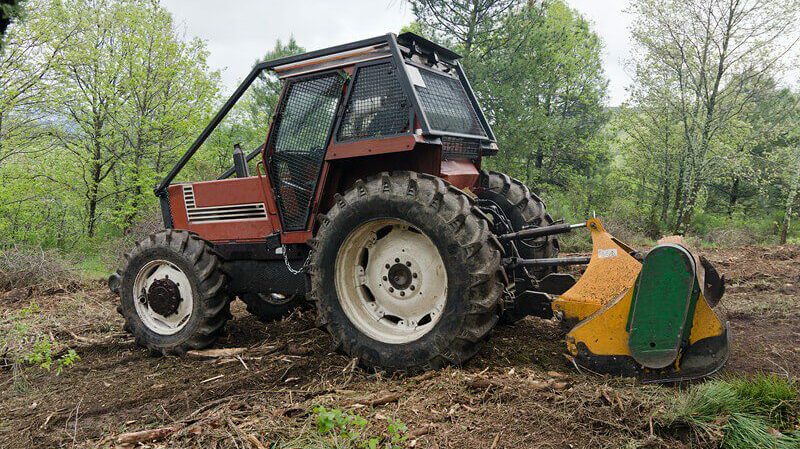Stump Grinder Teeth Guide: Buying, Sharpening and Storage

Stump grinding is one of the major activities in the landscaping and forestry industry, as it allows for the removal of unwanted tree stumps. The process requires a stump grinder, a machine designed to grind off stumps. These machines make use of cutter tools, stump grinder teeth, that eat away the stump by turning it into small pieces the size of sawdust. For stump removers, one of the major aspects of the process is getting the right stump grinder teeth.
With a plethora of options in the market, it can be tricky, especially for new buyers, to get the right teeth for their stump grinder. In addition, keeping the stump grinder teeth sharp and storing them properly can also be a major challenge. That’s what we will be looking at in this guide.
We have delved deeper into providing hacks that will enable stump grinder users to buy the right teeth and how to sharpen them and store them properly. Read more:
6 Factors When Buying Stump Grinder Teeth
When investing in stump grinder teeth, it’s paramount to consider several factors to ensure they align with your specific requirements. Here are 6 crucial factors to contemplate when purchasing stump grinder teeth:
Manufacturer:
The first thing you need to check out is the manufacturer. Where are you getting the teeth, and do they have a reputation for producing quality cutter tools? How is their experience and reliability? The manufacturer should have a good reputation in the industry. Visit JYF Machinery, a reputable stump grinder teeth producer and supplier.
Type of Teeth:
The type of teeth you choose significantly impacts their performance and durability. Straight teeth are ideal for softer wood and offer an economical option. Carbide-tipped teeth, on the other hand, are renowned for their superior durability and efficiency, making them suitable for grinding through tough stumps and roots. Multi-tip teeth provide versatility by combining cutting and mulching capabilities, making them a preferred choice for various grinding conditions.
Compatibility:
Ensuring compatibility between the teeth and your stump grinder model is essential for seamless operation. Teeth come in different sizes and configurations, so it’s crucial to select the right fit. Refer to your stump grinder’s specifications and consult with manufacturers or suppliers to determine the compatible teeth for your machine.
Quality and Durability:
Investing in high-quality teeth crafted from durable materials like carbide is paramount for long-term performance. Choose reputable brands known for producing reliable stump grinder teeth to ensure durability and resistance to wear and tear. Consider the tooth design and construction to ensure they can withstand the rigors of grinding tough stumps without premature wear.
Performance:
Evaluate the performance characteristics of the teeth, such as cutting efficiency and mulching capability. Opt for teeth with sharp cutting edges and efficient chip clearance to maximize grinding speed and effectiveness. The tooth design and configuration should be optimized for various grinding conditions, ensuring optimal performance across different wood types and soil conditions.
Cost and Value:
While cost is a significant consideration, prioritize value over the initial price. Investing in high-quality teeth may save you money in the long run by reducing downtime and replacement costs. Consider the overall value proposition, including factors such as durability, performance, and manufacturer support, to make an informed purchasing decision.
Sharpening stump grinder teeth is a critical maintenance task that ensures optimal performance and longevity of the cutting edges. Here’s a step-by-step process for sharpening stump grinder teeth:
Cleaning and Inspection:
Begin by cleaning the stump grinder teeth to remove any debris, dirt, or wood chips that may have accumulated during use. Use a brush or compressed air to clean the teeth thoroughly. Then, inspect each tooth for signs of wear, dullness, or damage to identify which teeth need sharpening.
Setting up the Sharpening Tool:
If using a diamond grinding wheel or sharpening machine, follow the manufacturer’s instructions for setup. Ensure the tool is securely mounted and adjusted to the correct sharpening angle for the stump grinder teeth.
Sharpening Technique:
Place the stump grinder tooth against the sharpening tool at the appropriate angle, typically between 25 to 30 degrees. Apply steady pressure and move the tooth back and forth across the sharpening surface to grind away any dull or damaged material. Maintain a consistent angle and pressure while sharpening each tooth to ensure uniformity and optimal cutting performance.
Checking Sharpness:
Periodically check the sharpness of the tooth by visually inspecting the cutting edge. A sharp tooth will have a clean, uniform edge free of any dull spots or imperfections. Continue sharpening until the desired sharpness is achieved.
Final Inspection:
Once all teeth have been sharpened, perform a final inspection to ensure that each tooth is sharp and free of any defects. Check for consistency across all teeth and make any necessary adjustments as needed.
Storage of Stump Grinder Teeth:
Proper storage is crucial for preserving the condition and effectiveness of stump grinder teeth when not in use. If not properly stored, the rate of wear and tear is likely to be very high. Here are storage tips for the teeth:
Clean and Dry:
Before storing, ensure that the teeth are thoroughly cleaned of any debris, dirt, or wood chips. Allow the teeth to dry completely to prevent moisture buildup, which can lead to rust and corrosion. This also helps to keep the teeth in perfect condition for a relatively longer time.
Organized Storage:
Store stump grinder teeth in a dry, climate-controlled environment away from direct sunlight and moisture. Organize teeth systematically to facilitate easy identification and access when needed. This will help reduce the small damages that come with teeth knocking on each other as you search through them.
Protective Measures:
Consider using protective cases or containers to prevent damage and maintain sharpness during storage. Avoid storing teeth in areas prone to temperature fluctuations or exposure to harsh elements.
Conclusion:
Stump grinder teeth are indispensable components in the stump removal process, and proper care and maintenance are essential to maximize their performance and longevity. By understanding the factors involved in buying, sharpening, and storing stump grinder teeth, you can ensure efficient and effective stump grinding operations for years to come.





